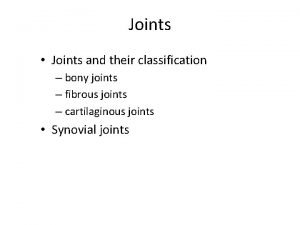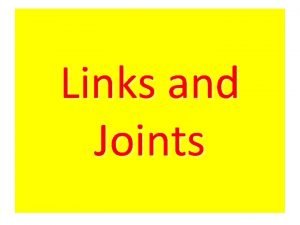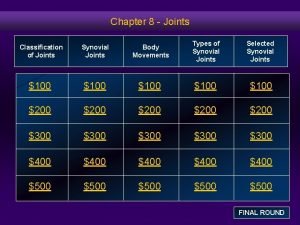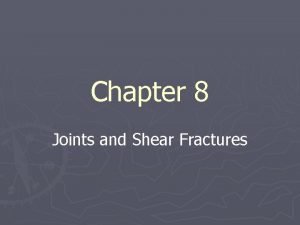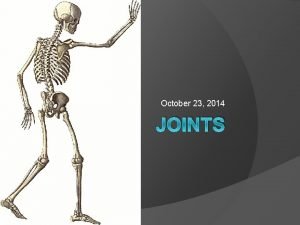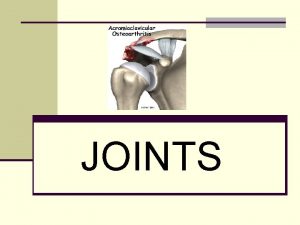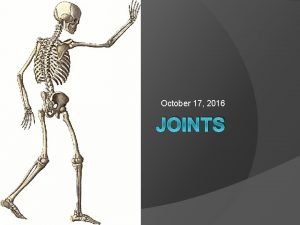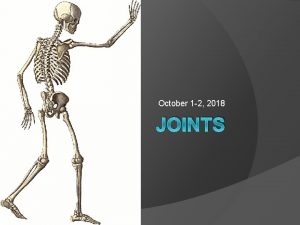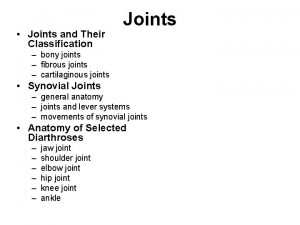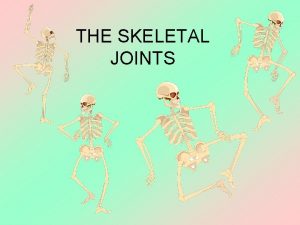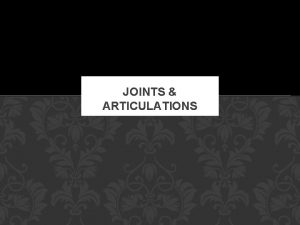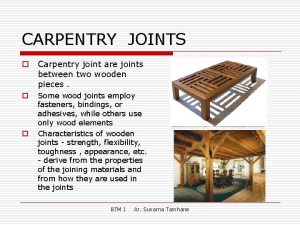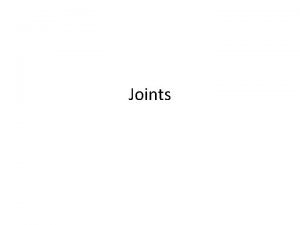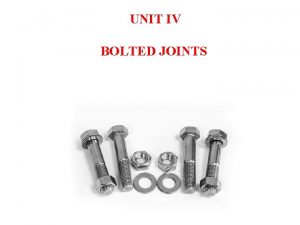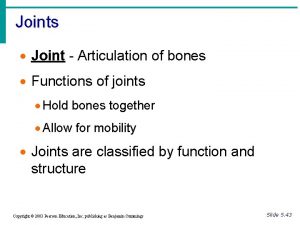Joints n n A joint is the site

















- Slides: 17


Joints n n A joint is the site of meeting of two or more bones. Joints are classified into three types (depending on the material that hold the articular bones together): Joints Fibrous joint Cartilaginous joint Synovial joint

Fibrous joints n n n Sutures: only seen in between the skull bones and they frequently ossify with age). Syndesmosis: n Inferior tibiofibular joint (no movement in this joints and never ossify). n Interosseous membrane connecting bones of forearm & leg. Gomphosis: in the joints between the teeth and jaws. Each tooth is connected to the socket by periodontal membrane.

Cartilaginous joints n Primary cartilaginous: these are temporary joints, in which the bones are connected by hyaline cartilage that ossifies with age. No movement is possible. This type is seen in: n Epiphyseal plate connecting epiphysis and metaphysis. n 1 st sternocostal joint between 1 st costal cartilage and sternum.

Cartilaginous joints n Secondary cartilaginous: the bones are connected by disc of fibrocartilage, which rarely ossifies with age. A small amount of movement is possible. These joints are seen in the joints of midline of body: Intervertebral discs n Symphysis pubis n Manubriosternal junction n

Synovial joints § are held together by fibrous capsule & characterized by presence of joint cavity. Synovial joints are freely movable and represent most joints of the body. § The capsule is lined by synovial membrane that secretes lubricating fluid (synovial fluid) for the articular surfaces. § Articular ends are covered by hyaline cartilage. § The capsule is thickened in certain parts to form ligaments, which provide strength and flexibility to the joint.

Synovial Joints n Allow considerable movement n Most joints that unite bones of axial and peripheral skeleton n Articular cartilage and disks n Joint cavity and capsule n n Synovial membrane and fluid Bursae

Types of synovial joints Type Plane Variety Plane Shape flat articulating surfaces Movement allow gliding or sliding movement Example Uniaxial (allow movement around one axis only) Hinge Pivot - concave surface with convex surface - movement occurs around transverse axis - flexion & extension - bony pivot surrounded by a ring - movement occurs around vertical axis - pronation & supination - rotation - oval convex surface fits into an ellipsoid concavity - movement occurs around 2 axes perpendicular to each other - flexion & extension - abduction & adduction Acromioclavicular J. Intercarpal js. Intertarsal js. . Elbow J. Interphalangeal Js. Radioulnar Js. Atlantoaxial Js. Biaxial (allow movements around two axis) Ellipsoid Saddle - both articular surfaces are - flexion & concavo-convex extension - movement in 2 axes like ellipsoid J. - abduction & with slight rotation adduction - slight rotation Carpometacarpal J. of thumb Multiaxial (allow movement around Ball & socket head of one bone fits into a cup-like concavity of other bone Shoulder J. Hip J. circumduction Wrist J. Metacarpophalangeal Js.


Types of Movement n n Angular n Flexion and Extension n Abduction and Adduction Circular n Rotation n Circumduction Flexion and Extension

Abduction and Adduction

Rotation and Pronation and Supination

Circumduction

Special Movements Unique to only one or two joints n Types n n Elevation and Depression n Protraction and Retraction

Elevation and Depression

Protraction and Retraction

Points to Remember n n n A joint or articulation is a meeting between two bones and does not necessarily imply movement A joint can be classified according to its structure Synovial joints are the most complex Specific terms are used to describe the movements of joints that are freely movable. Commonly grouped in opposing pairs that move a part of the body in relation to the anatomical position.
 Hot site cold site warm site disaster recovery
Hot site cold site warm site disaster recovery Quality grade of lamb
Quality grade of lamb External occipital protuberance
External occipital protuberance Which joint is permanent types
Which joint is permanent types Joint bank account in joint venture
Joint bank account in joint venture Lamb grading chart
Lamb grading chart Ellipsoid joint examples
Ellipsoid joint examples Hình ảnh bộ gõ cơ thể búng tay
Hình ảnh bộ gõ cơ thể búng tay Slidetodoc
Slidetodoc Bổ thể
Bổ thể Tỉ lệ cơ thể trẻ em
Tỉ lệ cơ thể trẻ em Gấu đi như thế nào
Gấu đi như thế nào Glasgow thang điểm
Glasgow thang điểm Hát lên người ơi alleluia
Hát lên người ơi alleluia Kể tên các môn thể thao
Kể tên các môn thể thao Thế nào là hệ số cao nhất
Thế nào là hệ số cao nhất Các châu lục và đại dương trên thế giới
Các châu lục và đại dương trên thế giới Công thức tính thế năng
Công thức tính thế năng


















